In 2013, Marantz?s unbeatable NA-11S1 network drive made a big impression on the world of digital music, both technically and musically, earning it a Qobuzism award.
Marantz has once again rocked the Hi-Fi scene with its HD-DAC1, an autonomous DAC with USB and S/PDIF inputs, as well as an amplifier for headphones, all the while retaining the brand?s classic aesthetics in a tastefully-designed compact format.
Capable of decoding digital audio files of up to 24-bit at 192kHz, and DSD files of 2.8 and 5.6MHz, the HD-DAC1 opts for simplicity of use, with rather limited settings and restricted connectivity options.
As the DAC aims to create the best sound quality possible, it uses the successful electronic circuits of HDAM and HDAM-S2, used after the conversion stages in CD/SACD players, and also in the Marantz network drives. These circuits are made up of discrete components that make the wonderful sounds, which are then communicated by the electronics.
We invite you to explore the Marantz HD-DAC1 with the following benchmark.
About the Marantz HD-DAC1
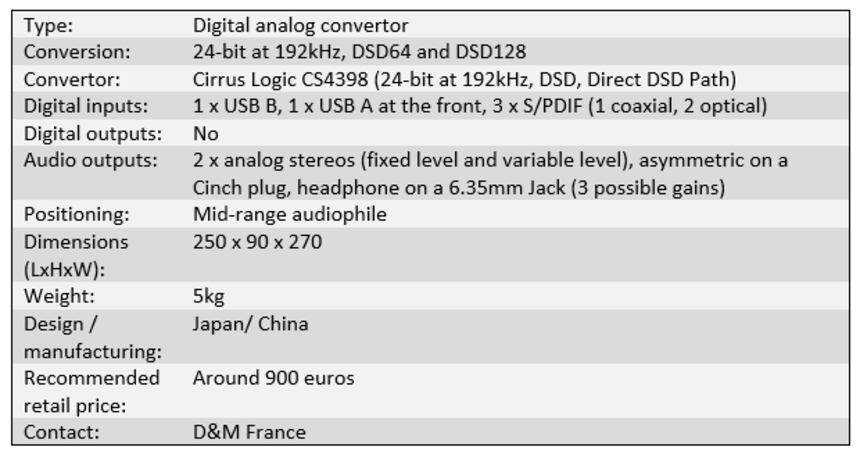
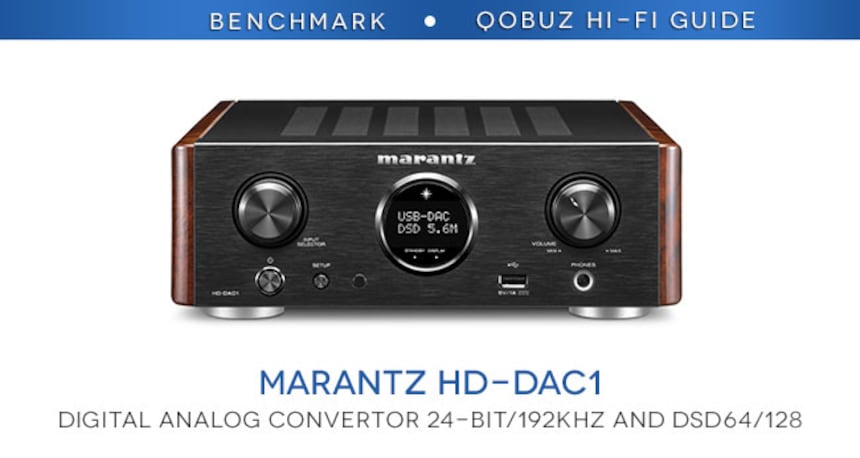
Presentation
Available in a silver or black finish, the Marantz HD-DAC1 has the brand?s characteristic timeless appearance that makes it immediately recognisable. The small screen in the middle of the frame is particularly elegant, displaying its lettering in a soft amber.
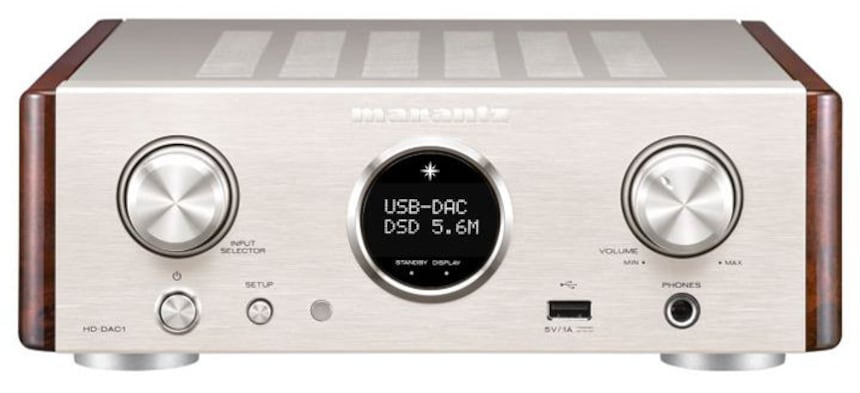

The aluminium frame is bordered by resin edges, which uncannily resemble the blackberry colour of dark mahogany. On the left hand side of the front face there is a large dial to select the sources sequentially, underneath which there lies the power button.
On the right there is a small button that enables you to choose several options, such as the gain of the amplifier for headphones (weak, average or high), the brightness of the screen, the automatic standby button, the option to connect to an iPhone, as well as a window for the remote control receptor.
Moving on, on the right hand side of the frame there is an USB A plug, enabling you to connect to an iPod, iPhone or an external USB storage device (limited playing of files of 16-bit at 48kHz max), a plug for headphones with a standard 6.35mm Jack, and a motorised potentiometer for controlling the volume.
Connectivity
There is a decent range of digital inputs on the Marantz HD-DAC1, with an USB B asynchronous input to connect to a computer, and three S/PDIF inputs, including one coaxial and two optical.
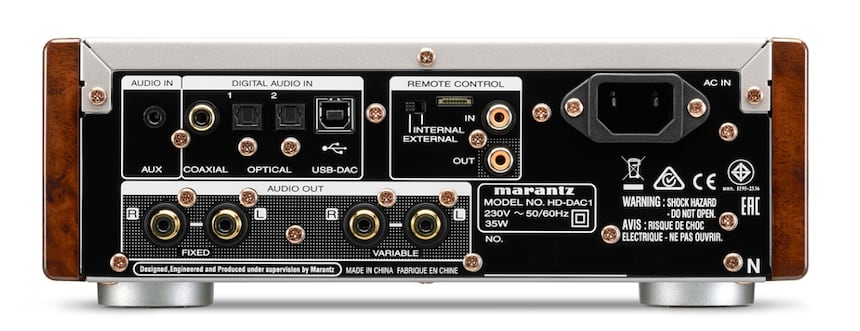
The analog signals are available on two pairs of carefully crafted Cinch jacks. One of them provides a fixed level in order to be connected to an additional input, whilst the other delivers a variable level, enabling you to directly attach a stereo power supply, or powered speakers.
There is also an analog stereo input on a Jack of 3.5mm and the possibility to connect the remote control?s signals to other Marantz devices.
Manufacturing
The HD-DAC1?s steel frame interior does not waste any space. A good third of it is occupied by a serious reversed power supply transformer, and the main and standby power supplies.
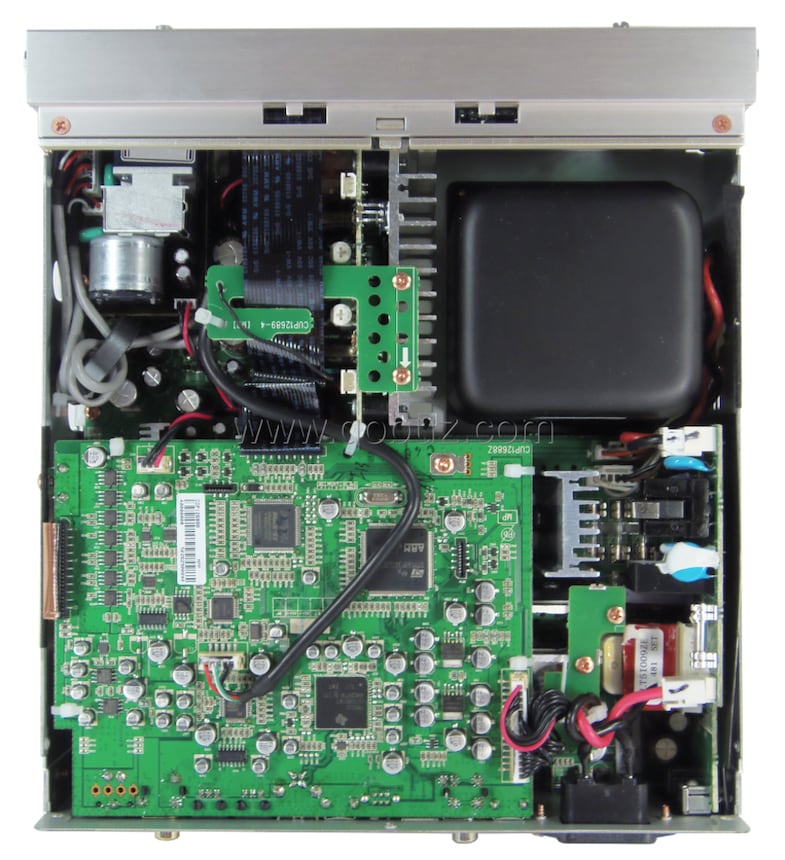
Despite this density, it wasn?t difficult to dissect the DAC to discover its insides, in particular those hidden by the digital card that is located in the upper section.
The USB interface is ensured by a digital processor of the TMS320C6748 Texas Instruments signal (the upper part of the photo below, slightly to the left).
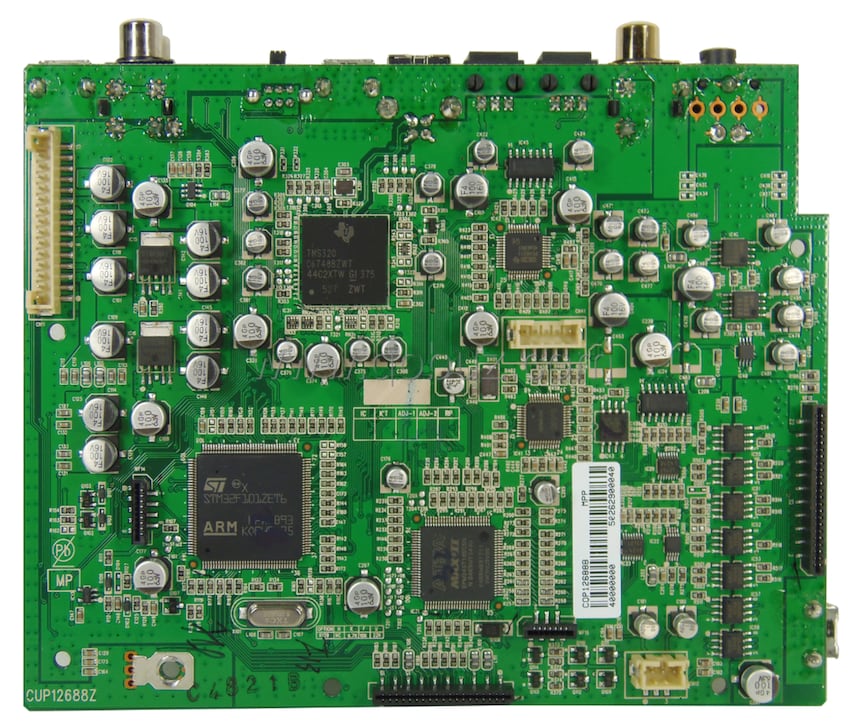
There is an ARM STM32F101 micro controller of a S/T Semiconductor, which extracts the signals, whereas the CPLD circuit (Complex Programmable Logic Device), ALtera Max II uses the digital filter.
On the right of the TMS320C6748 processor there is a Burr-Brown PCM9211 receiver transmitter (transceiver), of 24-bit at 216kHz, which ensures both the reception and switching of digital signals coming from the S/PDIF inputs, and the digitalisation of 24-bit at 96kHz of analog signals present on the Jack input of 3.5mm.
These analog signals travel through the low-pass filters built around the NJM2115 operational amplifiers (the two little circuits on the upper right part) of JRC (New Japan Radio Company). This is in order to avoid any phenomenon of spectral aliasing during the digital-analog conversion.
Marantz uses the Analog Devices ADUM1280 and ADUM1285 insulators (the well-aligned chips on the bottom right), between this card and the digital analog conversion part, in order to isolate them electronically. This is because the power feed (and the mass) of the digital circuits can produce sounds and other parasites, which risks polluting the analogical signals.
On the other side of the card, (which we removed the cardboard box as it was covered by a copper sheet to block the radiation), there are only very few active components. You can see this in the galvanized zone isolated from the rest of the electronics that we mentioned in the preceding paragraph (the area on the bottom left).
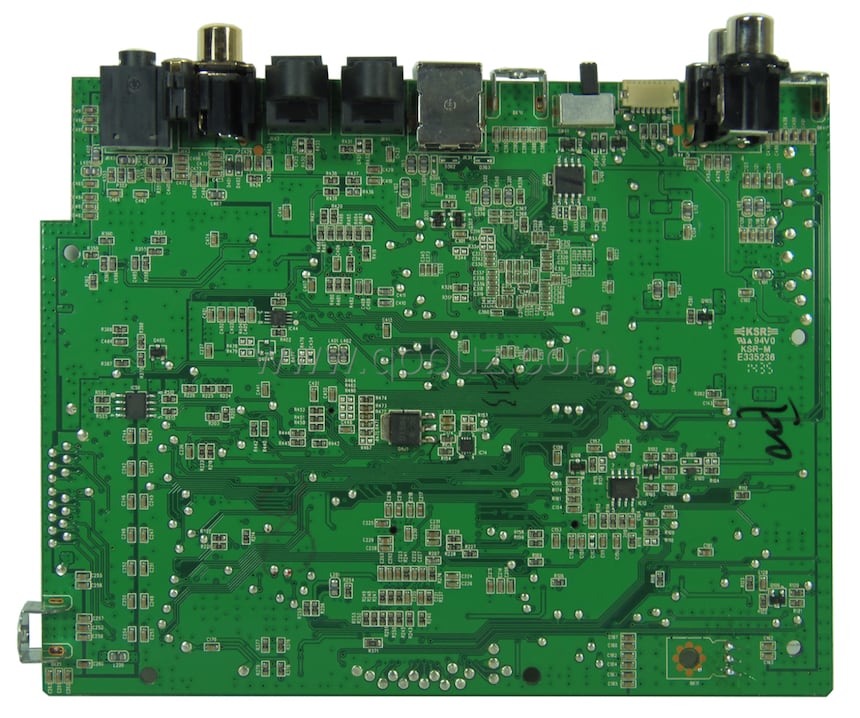
Digital-Analog Conversion, HDAM HDAM-SA2 circuits
The I2S bus originating from the digital card manages the digital analog conversion chip, via a flexible circuit connected to the white connector on the left of the image below.
This digital-analog conversion circuit, found immediately on the right of the connector, is a Cirrus Logic CS4398, which accepts audio digital signals of up to 192kHz on 24-bit. It also accepts DSD signals, as it internally converts them into PCM signals, or directly filters them on the low-pass. This depends on the original design of the DSD, via programming some of its internal registers (Direct DSD path).
However we do not know whether Marantz has made use of this possibility.
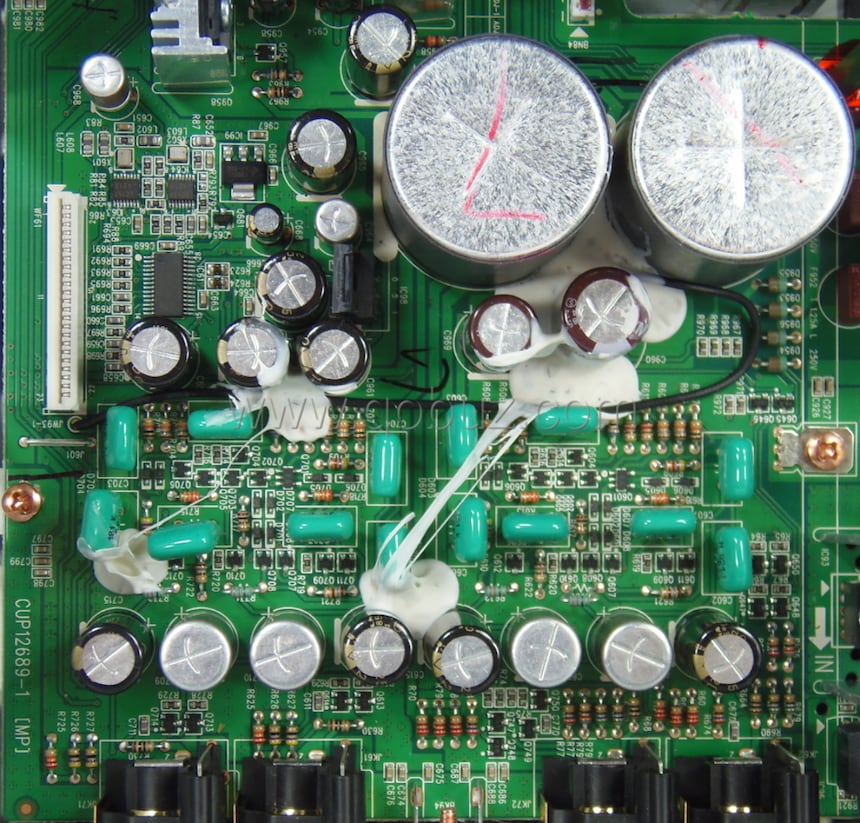
The analogical signals on the CS4398 output are filtered by Marantz?s own HDAM and HDAM-SA2 circuits, which are entirely made up of discrete components. The condensers are layered models of an audiophile quality.
Also noteworthy are the HDAM circuits that filter the power supply, which are position just before the output connecters. At the top of the card, two large Nichicon condensers of 6800 ?F/25V smooth the current from the power feed LED diodes? bridge output.
The amplifier for headphones is made up of discrete components, and uses powerful transistors in a conventional case, mounted on an aluminium winged heat dissipater.
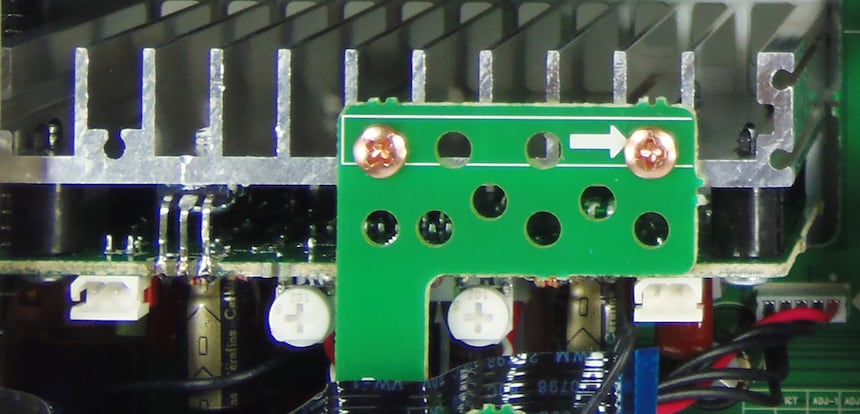
Listening
The sound delivered by the Marantz HD-DAC1 is like the wooden sides that adorn its frame: rich and full.
We started with the overture Peter Schmoll und seine Nachbarn, an extract from the album Weber?s overtures from the very subtle and novel interpretation by Jean-Jacques Kantorow at the head of the Tapiola Sinfonietta. We listened to it in the Studio Masters version of 24-bit at 44.1kHz. The stacattos were sharp, whilst the sound reproduction was filled with a reassuring richness and warmth.
Next we listened to the Introduzione al Dixit RV 635: III.Sternite, Angeli from the superb album of Vivaldi?s Gloria and Dixit Dominus with Rinaldo Alessandrini at the head of the Concerto Italiano. The chords ran freely and there was an easing in the higher ranges, producing a soft sound.
The Marantz HD-DAC1 accentuates the spirituality and depth of the 70s track My Sweet Lord from the album Let It Roll by George Harrison, by sweetening the sound and the guitar chords.
We then listened to La Japonaise, an extract from the album Barcelona, in its Studio Masters version of 24-bit at 96kHz. However, the HD-DAC1 makes the voices of Freddie Mercury and Montserrat Caballé lose some of their brightness, creating a certain gravity and solemnity to the song. However, this also increases its richness, whilst the piano sounds majestic.
A very beautiful, warm and fluid sound restitution is produced when playing the song The Upsetter from the album Love Letters by Metronomy. You unwittingly let yourself be soothed, forgetting all your troubles.
Finally we listened in DSD64 and DSD128 to Mozart's allegro of the concerto in D major for violin, and the Divertimenti from the Simple Symphony by Britten, downloaded on 2L.no. The sound restitution produced by the Marantz HD-DAC1 prevented the music from being harsh, particularly at the top of the range, proving to me a lot more incisive than other DACs. You also notice this in the chords of the Simple Symphony.
We listened to the majority of these tracks via a headphone, and we were impressed by its excellent quality and ability to deliver a strong sound reproduction.
To conclude this HD-DAC1 digital-analog convertor is typical of the Marantz brand. Easy to use, compatible with audio digital files of 24-bit at 192kHz and DSD64 and 128, it provides a very beautiful, warm and rounded sound restitution. Everything is assembled together in a luxurious frame, blessed with the native charm of Marantz devices. If this sounds good, go for it.
HD-DAC1 on the Marantz web site
Reading Capabilities
Marantz HD-DAC1
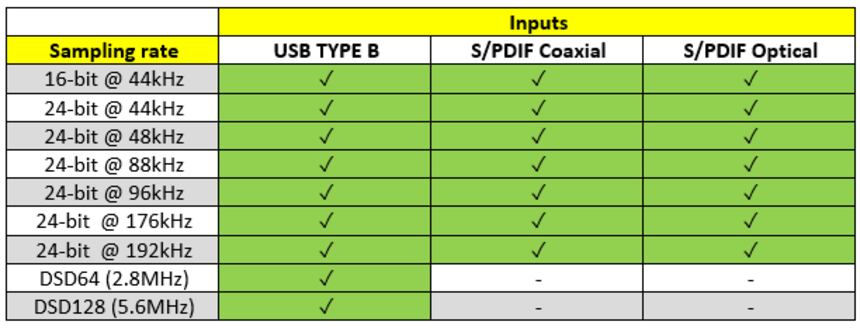
If you are a manufacturer, importer, distributor or actor in the domain of sound reproduction and you wish to contact us, please do so using the following address: newstech@qobuz.com
If you are passionate about our Hi-Fi Guide and you wish to contact us, please do so using the following address: rubriquehifi@qobuz.com
